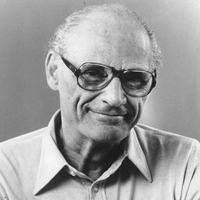Dramatic Technique in Death of a Salesman
Expressionism the most dominant dramatic technique of Arthur Miller. This technique has witnessed its full-fledged application in The Death of a Salesman. Expressionism is a theatrical device to express the inherently hidden truths concerning the characters in the drama. The playwright, whose handy dramatic device is expressionism, believes that modern people are not honest, not only with others but with themselves.

Arthur Miller (1915-2005)
Modern people tend to be hypocritical by nature. Their outer self can't be the exact and accurate manifestation of their inner core self. They manifest personalities and their latent essence. There has developed a gigantic gap between the essence and personality of modern people. Because of their dishonesty to themselves, modern playwright has faced a considerable number of difficulties in conveying the basic realities of modern characters, modern people. That is why modern playwrights have decided to choose a somewhat different and suitable technique of rendering realism. This technique is called expressionism. Upon analysis, we come to know that there is another motivation behind the modern dramatist's search for the technique of expression. It is true that modern playwrights were disenchanted with the 19th century technique of realism. Modern playwrights believed that the 19th century realism is incomplete and passive. They began to detest the 19th century's passive realism. Due to their detestation, they hankered after active realism. To put forward the active realism they developed several devices like the device of symbolism, the device of including gesture, the device of music and the device of including the unusual mentality of the protagonist. To express the hidden reality of character playwrights of expressionistic plays make use of countless relevant devices. Like these devices Miller's Death of a Salesman makes use of lots of similar devices to attain the standard target of an expressionistic play. To reveal the true nature of Willy Loman Arthur Miller made use of Music. The music is symbolic of Willy Loman's nostalgia for the lost paradise of rusticity of the New England.
When Willy Loman talks about his past, he is not found in a position to remember his past. Rather, his whole past return and makes him, uprooted in the present. This situation in which Willy Loman lives is expressive of many things associated with the inner psychological lives of character typically Willy Loman.
Except this technique of expressionism, there are lots of other techniques at work in the play. Miller has deliberately blurred the past and the present of Willy Loman. By blurring the boundary of the past and the present, Miller has tried to throw dramatic spotlight upon the suicidal predicament of Willy Loman. To demonstrate the psychic nature of a frustrated and suicidal man Arthur Miller has not divided Act into scenes. Moreover, Miller has divided the play into two Acts only. By limiting the extensive division of action into several acts, Arthur Miller actually wanted to keep unity of time and action intact. This unity of time and action contributed to the credibility and appropriateness of an expressionist reality. By not dividing acts into scenes the playwright succeeded in capturing the smooth continuity of uninterrupted action demanding perfect coherence.
Miller's masterpiece The Death of a Salesman enjoyed its unprecedented popularity created solely by the effectiveness of the following technique. This technique is Miller's subtle art of making his play affiliated and disaffiliated with the classical tragic convention. Most importantly the play has violated the established generic convention of a Greek tragedy. It has a layman from a working class background as its protagonist. It does not permit its characters to speak in the language of poetry. Characters of Death of a Salesman Speaks in the language of colloquial, informal prose. Furthermore this play of Miller is subversive of the chronological unfolding of the plot. It has, on the contrary, lays emphasis upon the circular unfolding of the plot. In the expansion of plot of Death of a Salesman both the past and the present coincide rendering entire experiences confused and chaotic.
Last but not the least, Miller has declined to abide by the basic principle of allowing main characters converse in the language of poetry. In this move Arthur Miller seems to be somewhat radical. To write a tragedy like Death of a Salesman on such a common theme, in such a common language is really a radical feat of radical dramatic achievement. But upon reflection we come to know that, contrary to his preconceived intention, most of the characters in the play speak in figurative language. Like:
Linda: Take care of him, Biff. He is a troubled boat looking for harbor.
Willy: I am not a dime a dozen, I am Willy Loman.
Death of a Salesman Study Center
Disturbed Gender Relation and Dysfunctional Family in Death of a Salesman
Subversive Nature of Language in Death of a Salesman
The Suicidal Causes of Willy Loman in Death of a Salesman
Death of a Salesman Study Center
Introduction of Death of a Salesman
Summary of Death of a Salesman
Style in Miller's Death of a Salesman
Themes of Miller's Death of a Salesman
 |
bachelorandmaster.com |